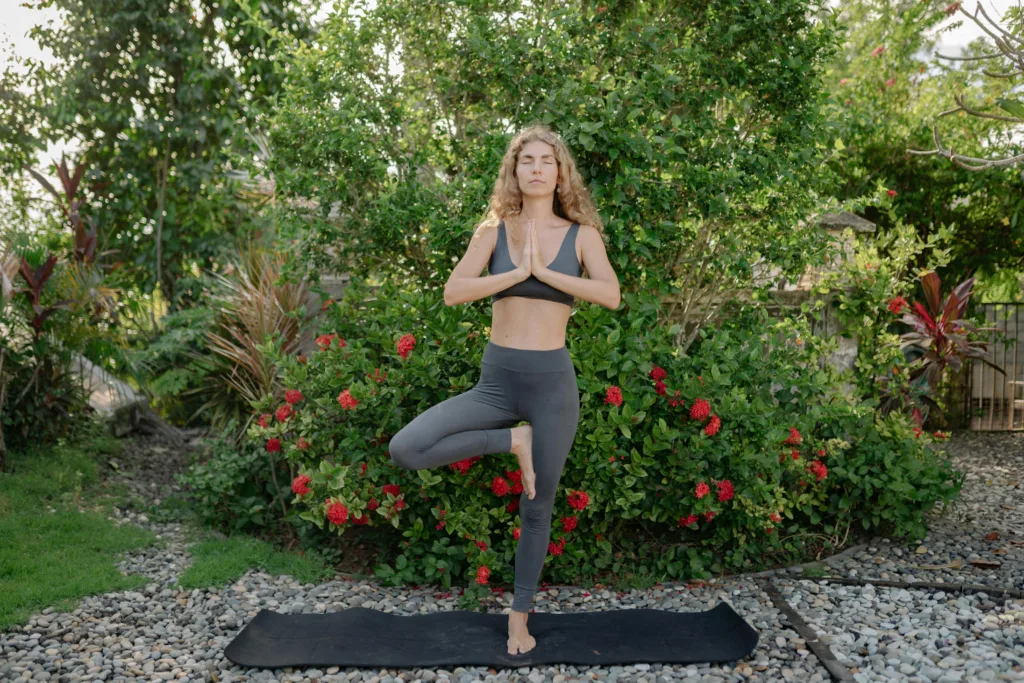Yoga has long been a pathway to holistic wellness, offering mental peace, physical strength, and emotional balance. Among its many poses, Vrikshasana (Tree Pose) holds a unique place. This single-legged balancing pose not only symbolizes stability and growth but also delivers remarkable benefits for the mind and body. Let’s dive deep into the nuances of Vrikshasana, its benefits, steps to perform it correctly, and how it compares to another popular pose—Warrior Pose.

Vrikshasana, derived from the Sanskrit words “Vriksha” (tree) and “Asana” (pose), mimics the steady stance of a tree. It is a beginner-friendly standing pose that focuses on balance, concentration, and flexibility. Whether you’re a yoga novice or a seasoned practitioner, Vrikshasana is an excellent choice for cultivating both physical and mental steadiness.
Improves Balance and Stability
Standing on one leg enhances your sense of equilibrium and strengthens the stabilizing muscles of the ankles, knees, and hips. Vrikshasana is an essential standing balance yoga pose to include in your routine.
Strengthens Leg Muscles
This pose engages the thighs, calves, and feet, improving muscle tone and endurance. Tree Pose for strengthening leg muscles is particularly beneficial for athletes and beginners alike.
Enhances Concentration
The focus required to hold this pose improves mental clarity and reduces distractions, making it a powerful mindfulness practice. Practicing Tree Pose for beginners is a great way to build focus and improve posture.
Promotes Core Strength
Engaging the abdominal muscles during Vrikshasana helps improve core stability and posture. It’s an excellent yoga pose to strengthen legs and core simultaneously.
Boosts Joint Flexibility
This pose opens the hips and stretches the groin, aiding in joint flexibility and mobility. Tree Pose for flexibility is ideal for people looking to enhance their range of motion.
Supports Emotional Balance
Practicing Vrikshasana encourages a meditative state, reducing stress and fostering emotional resilience.
Start with Tadasana (Mountain Pose): Stand tall with your feet together, shoulders relaxed, and arms at your sides. Tree Pose alignment tips can help you get the most out of this starting position.
Shift Your Weight: Transfer your body weight to your left leg, keeping it firm and grounded.
Position Your Right Foot: Place the sole of your right foot on your inner left thigh or calf (avoid the knee joint). For Tree Pose for kids, encourage proper alignment to avoid strain.
Bring Your Hands to Prayer: Raise your arms and join your palms in a prayer position at your chest or above your head.
Maintain the Pose: Focus on a fixed point in front of you, hold for 15–30 seconds, and breathe deeply. Vrksasana steps are easy to follow and beginner-friendly.
Release Gently: Lower your hands and foot, then repeat on the opposite side.
Placing Foot on the Knee Joint: This can cause strain on the knee. Always position your foot above or below the knee. Tree Pose instructions often emphasize this key point.
Hunching the Back: Ensure your spine remains straight throughout the pose.
Looking Down: Fix your gaze forward or slightly upward to maintain balance.
Use a wall or chair for support if balancing feels challenging initially. Practicing Tree Pose for balance practice with support is a great starting point.
Start with shorter holds and gradually increase your duration.
Focus on slow, steady breathing to stabilize your pose.
Similarities
Both poses enhance balance, focus, and leg strength.
They engage core muscles and promote mental clarity.
Differences
| Feature | Vrikshasana (Tree Pose) | Warrior Pose (Virabhadrasana) |
|---|---|---|
| Body Posture | One-legged pose, upright alignment | Lunge-like stance with extended arms |
| Primary Focus | Stability and mindfulness | Strength and stamina |
| Skill Level | Beginner-friendly | Suitable for intermediate practitioners |
| Flexibility Target | Hips and groin | Shoulders, chest, and legs |
If you’re looking for a calming pose, choose Vrikshasana. For a more dynamic, energy-boosting asana, opt for Warrior Pose. Combining Tree Pose benefits with Warrior Pose’s strength-building attributes can provide a well-rounded yoga practice.
Practicing Vrikshasana daily can significantly improve your overall well-being. Its emphasis on grounding reflects the importance of staying connected to your roots while aiming for personal growth, much like a tree reaching for the sky. By incorporating Tree Pose yoga posture into your routine, you nurture both physical and emotional stability.
What are the mental benefits of Vrikshasana?
Vrikshasana improves focus, concentration, and emotional stability, promoting a meditative state. Tree Pose benefits extend beyond physical improvements.
Can beginners practice Vrikshasana?
Yes, it’s ideal for beginners. Use support if needed, and gradually build balance and confidence. How to do Vrksasana correctly is key to beginners’ success.
How long should I hold Tree Pose?
Hold it for 15–30 seconds on each side initially, and increase duration as your balance improves.
Is Vrikshasana safe for everyone?
It’s safe for most people but consult a yoga instructor if you have severe knee or ankle issues.
What is the difference between Vrikshasana and Warrior Pose?
While Vrikshasana focuses on balance and mindfulness, Warrior Pose emphasizes strength, stamina, and energy.
Does Tree Pose help with posture?
Yes, it strengthens core and back muscles, promoting an upright posture. Practicing improve posture yoga poses like Vrikshasana is beneficial for daily life.
